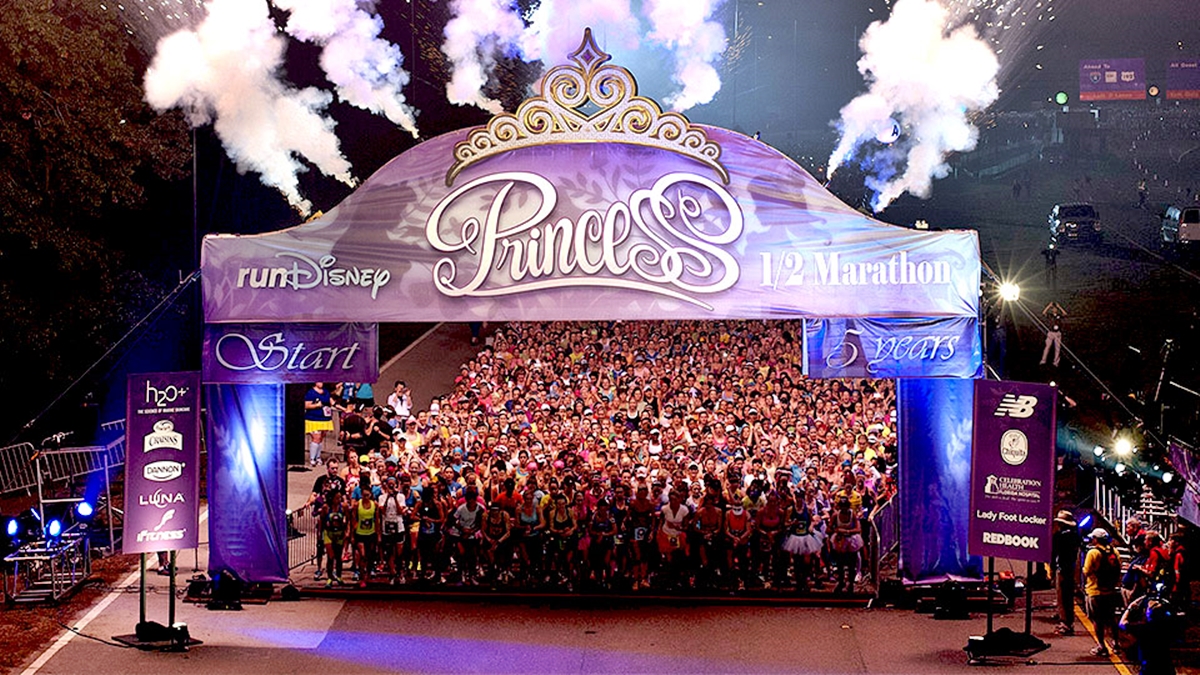

Featured
How Often Can You Run A Half Marathon
Modified: January 2, 2024
"Learn about the best training practices and find out how often you can run a half marathon. Get featured tips from experienced runners.
Introduction
Running a half marathon is a significant accomplishment that requires dedication, training, and determination. Whether you’re a seasoned runner or a beginner looking to challenge yourself, deciding on the frequency of your half marathon runs is a crucial aspect of your training plan.
When it comes to determining how often you can run a half marathon, there isn’t a one-size-fits-all answer. Several factors come into play, including your current fitness level, training experience, injury history, and overall goals. Striking the right balance between training intensity and recovery is key to avoid overexertion and maximize performance.
While there are general guidelines to consider, it’s important to listen to your body and tailor your training frequency to your individual needs. This article will delve into the factors to consider when deciding how often you can run a half marathon and provide tips on how to build a training plan that works for you.
Before diving into the specifics, it’s essential to recognize that training frequency is just one component of a well-rounded training regimen. Proper nutrition, adequate rest, cross-training, and injury prevention strategies are equally important aspects to consider when preparing for a half marathon.
So, let’s explore the factors that will help guide you in determining how often you can run a half marathon!
Training Frequency for Half Marathon
When it comes to training for a half marathon, finding the right balance between training frequency and recovery is crucial. Training too frequently can lead to overuse injuries, burnout, and decreased performance, while not training frequently enough may result in insufficient conditioning and decreased race-day performance.
The recommended training frequency for a half marathon typically ranges from three to five days per week. This allows for a mix of running, cross-training, and rest days, which are all essential for a well-rounded training plan.
If you’re a beginner runner, it’s generally advisable to start with three to four training days per week. This frequency provides enough time for your body to adapt to the increased demands of running and helps prevent overuse injuries. As you progress and become more comfortable with the distance, you may choose to increase your training frequency to four or five days per week.
For more experienced runners, training five days per week is commonly recommended. This frequency allows for a greater focus on improving speed, endurance, and overall performance. However, it’s crucial to balance this increased frequency with adequate rest and recovery days.
It’s important to note that each training day doesn’t have to consist of long runs or high-intensity workouts. A well-rounded training plan includes a mix of easy runs, tempo runs, interval training, cross-training activities like cycling or swimming, and rest days. This variety helps prevent overuse injuries, promotes muscle recovery, and improves overall fitness.
As with any training plan, it’s essential to listen to your body. If you’re feeling excessively fatigued or experiencing pain, it may be a sign that you need to reduce your training frequency or incorporate additional rest days. Ignoring these warning signs can lead to overtraining and hinder your progress.
The specific training frequency that works for you will depend on several factors, including your current fitness level, training experience, and individual recovery capacity. It’s always a good idea to consult with a running coach or healthcare professional to help tailor your training plan to your specific needs.
Now that we’ve covered the recommended training frequency for a half marathon, let’s explore the factors that need to be considered when deciding on your ideal training plan.
Factors to Consider
When determining the optimal training frequency for your half marathon, several factors need to be taken into account. These factors will vary from person to person and can greatly influence your ability to handle a certain training load. Here are some key considerations:
- Current Fitness Level: Your current fitness level plays a significant role in determining your training frequency. If you are new to running or have a lower fitness level, it’s important to start gradually and build up your running volume over time. Beginners may benefit from starting with three to four running days per week and gradually increasing from there as their fitness improves.
- Training Experience: Experienced runners who have already completed half marathons or other endurance events may be able to handle a higher training frequency. It’s important to take into account the training programs you have successfully completed in the past and adjust your training frequency accordingly.
- Injury History: If you have a history of running-related injuries or other musculoskeletal issues, it’s crucial to prioritize proper recovery and injury prevention. In such cases, incorporating rest days and cross-training activities can help reduce the risk of overuse injuries and ensure a sustainable training routine.
- Time Availability: Consider your schedule and time availability when determining your training frequency. If your schedule is packed and you have limited time for training, you may need to adjust your expectations and focus on maximizing the quality of your workouts rather than the quantity.
- Overall Goals: Your overall goals for the half marathon also play a role in determining your training frequency. If you’re aiming for a specific time goal or looking to improve your performance, you may need to increase your training volume and frequency accordingly. On the other hand, if your goal is simply to complete the race and enjoy the experience, a lower training frequency may be sufficient.
It’s important to remember that everyone is different, and what works for one person may not work for another. It may require some trial and error to find the optimal training frequency that suits your individual needs and goals. It’s always a good idea to consult with a running coach or healthcare professional who can provide personalized guidance based on your specific circumstances.
Now that we’ve explored the factors to consider, let’s move on to building a training plan that incorporates the right balance of training and recovery.
Building a Training Plan
Building a well-rounded training plan for a half marathon involves strategically balancing training frequency, mileage, and rest days. Here are some key considerations to keep in mind when creating your training plan:
- Gradual Progression: It’s important to gradually increase your mileage and training intensity to allow your body to adapt and prevent injuries. Start with a solid base mileage and gradually add mileage and intensity over time. Aim to increase your mileage by no more than 10% each week to avoid overexertion.
- Structured Workouts: Incorporate a mix of different types of workouts, including long runs, tempo runs, interval training, and easy recovery runs, throughout your training plan. Varying your workouts will help improve different aspects of your running performance and prevent boredom.
- Rest and Recovery: Rest and recovery are just as important as training for optimal performance. Schedule regular rest days to allow your muscles to repair and recharge. Additionally, consider incorporating active recovery activities such as yoga or gentle stretching on rest days to promote blood flow and flexibility.
- Cross-Training: Don’t neglect cross-training activities such as cycling, swimming, or strength training. These activities can help improve overall fitness, prevent overuse injuries, and provide a break from the impact of running.
- List itemDiet and Hydration: Proper nutrition and hydration are vital for fueling your training and optimizing performance. Make sure to eat a balanced diet rich in carbohydrates, protein, and healthy fats, and stay adequately hydrated throughout your training.
- Mental Preparation: Half marathons can be physically and mentally challenging. Incorporate mental preparation techniques such as visualization, positive self-talk, and goal setting to help you stay motivated and focused during training and on race day.
As you build your training plan, keep track of your progress, listen to your body, and make adjustments as needed. Remember that flexibility is key, and it’s important to be adaptable to accommodate unforeseen circumstances or changes in your body’s response to training.
A well-designed training plan should provide a balance between pushing yourself to improve and allowing for ample rest and recovery. Remember, the goal is to arrive at the starting line feeling strong, confident, and injury-free.
Now that we’ve covered the key aspects of building a training plan, let’s dive into the importance of balancing rest and recovery in your half marathon training.
Balancing Rest and Recovery
Rest and recovery are essential components of any training plan, especially when it comes to preparing for a half marathon. They give your body the time it needs to repair and adapt, ultimately leading to improved performance and injury prevention. Here are some key considerations for balancing rest and recovery in your training:
- Scheduled Rest Days: Schedule at least one or two rest days each week where you don’t engage in any intense workouts. This allows your muscles, tendons, and ligaments to recover and rebuild. Use these days to focus on gentle stretching, foam rolling, or other recovery activities.
- Active Recovery: Incorporate active recovery activities on your rest days, such as gentle yoga, swimming, or walking. These low-impact activities help promote blood circulation, enhance muscle recovery, and reduce muscle soreness.
- Proper Sleep: Getting enough quality sleep is crucial for recovery and overall performance. Aim for 7-9 hours of uninterrupted sleep each night to allow your body to repair and recharge. Establishing a consistent sleep routine can help optimize recovery.
- Nutrition: Proper nutrition plays a vital role in recovery. Make sure to consume a balanced diet rich in carbohydrates, protein, and healthy fats to provide your body with the necessary nutrients for muscle repair and replenishing glycogen stores.
- Hydration: Stay properly hydrated throughout your training to support optimal muscle function and recovery. Adequate hydration helps in the removal of metabolic waste products, reduces the risk of cramps, and aids in the delivery of nutrients throughout the body.
- Listen to Your Body: Pay attention to how your body feels during and after workouts. If you’re experiencing excessive fatigue, persistent muscle soreness, or any signs of injury, it’s essential to take additional rest days or modify your training plan accordingly.
Remember, rest and recovery are not solely limited to rest days. It’s important to incorporate easy or recovery runs into your training schedule as well. These runs should be done at a comfortable pace where you can maintain a conversation without feeling overly fatigued.
Keep in mind that everyone’s recovery needs are different. Factors such as age, training volume, and individual recovery capacity all play a role. Be mindful of your own body’s signals and adjust your training and recovery accordingly.
By prioritizing rest and recovery, you allow your body to adapt and become stronger, which ultimately enhances your performance on race day. So, remember to find the balance between pushing yourself during training and giving your body the time it needs to rest and recover.
Now, let’s explore the potential effects of overtraining and how to avoid them in your half marathon training.
Effects of Overtraining
Overtraining occurs when the body is subjected to more training stress than it can handle or when there is insufficient time for recovery. Pushing your body beyond its limit can have detrimental effects on your performance, health, and overall well-being. Here are some potential effects of overtraining to be aware of:
- Decreased Performance: Overtraining can lead to a decline in performance rather than improvement. Persistent fatigue and sluggishness may hinder your ability to meet speed or endurance goals.
- Increased Risk of Injury: Overtraining places excessive stress on your muscles, tendons, and joints, increasing the risk of overuse injuries such as shin splints, stress fractures, and tendinitis.
- Mental and Emotional Exhaustion: Overtraining can lead to mental and emotional exhaustion, often referred to as “burnout.” This can manifest as a lack of motivation, irritability, mood swings, and a general feeling of low energy and enthusiasm towards running.
- Immunosuppression: Pushing your body beyond its limits for extended periods can weaken your immune system, making you more susceptible to illnesses and infections.
- Disrupted Sleep Patterns: Overtraining can interfere with your sleep patterns, making it difficult to fall asleep or stay asleep. Inadequate sleep impairs recovery and hampers overall well-being.
- Hormonal Imbalances: Intense and prolonged training without sufficient recovery can disrupt hormone balance in the body. This can result in irregular menstrual cycles in women and decreased testosterone levels in men.
- Loss of Enjoyment: Overtraining can lead to a loss of enjoyment in running and decrease your overall motivation to participate in races or training. It’s important to maintain a healthy and balanced approach to running to keep the passion alive.
It’s essential to listen to your body and recognize the signs of overtraining before it escalates. If you experience chronic fatigue, persistent muscle soreness, frequent injuries, changes in mood or sleep patterns, or a decline in performance, it’s crucial to take a step back and reassess your training plan.
Preventing overtraining is about finding the right balance between training stress and recovery. Incorporate rest days, cross-training activities, proper nutrition, and adequate sleep into your training plan to promote optimum recovery and minimize the risk of overtraining.
Now that we’ve discussed the effects of overtraining, let’s explore how to adjust training frequency based on different experience levels.
Adjusting Frequency Based on Experience Level
When it comes to determining the training frequency for a half marathon, your experience level plays a crucial role. As you gain more experience and build a solid fitness foundation, you can gradually adjust your training frequency to meet your specific goals and needs. Here’s how you can modify your training frequency based on your experience level:
Beginners: If you’re new to running or have limited running experience, it’s important to start slowly and gradually increase your training frequency. Begin with three to four training days per week, allowing for rest and recovery days between each session. This frequency allows your body to adapt to the demands of running without overwhelming it. As you progress and become more comfortable with the distance, you can gradually increase your training frequency to four or five days per week, depending on your body’s response.
Intermediate Runners: Intermediate runners who have some running experience and have completed a half marathon or similar distance can increase their training frequency to four or five days per week. This allows for a more focused approach to improving performance, building endurance, and incorporating specific workouts. However, it’s important to balance this increased frequency with adequate rest and recovery days to prevent overtraining and reduce the risk of injury.
Advanced Runners: Advanced runners who have a strong foundation of training and multiple half marathon or marathon experiences can handle a higher training frequency. Five to six days per week of running can be appropriate for advanced runners, with a combination of easy runs, speed workouts, long runs, and recovery runs. These runners should have a good understanding of their body’s response to training and be mindful of potential signs of overtraining.
It’s important to note that adjusting your training frequency should be done gradually. It’s not advised to jump from running two days a week to five days a week immediately. Listen to your body, monitor your progress, and make adjustments accordingly. If you start to experience excessive fatigue, persistent soreness, or a decline in performance, it may be a sign that you need to scale back your training frequency and incorporate additional rest days.
Remember, regardless of your experience level, recovery and rest days are crucial for allowing your body to repair and adapt to the training stress. Don’t underestimate the power of a well-placed rest day in helping you achieve your goals and staying injury-free.
Now that we’ve explored adjusting training frequency based on experience level, let’s discuss the importance of listening to your body during training.
Listening to Your Body
When it comes to training for a half marathon, listening to your body is one of the most vital aspects of a successful and sustainable training plan. Your body has a unique way of communicating its needs, and paying attention to its signals can help you avoid overtraining, prevent injuries, and optimize your performance. Here are some key points to consider when listening to your body during training:
- Pay Attention to Fatigue: Fatigue is a natural part of training, especially as the mileage increases. However, it’s important to differentiate between general fatigue and excessive fatigue that persists throughout the day. If you’re feeling excessively tired, it may be a sign that you need to adjust your training or incorporate additional rest days to allow for proper recovery.
- Monitor Muscle Soreness: Feeling some muscle soreness after a challenging workout is normal. However, persistent and intense muscle soreness that hinders your ability to perform daily tasks may be an indication that your body needs more time to recover. Consider adjusting your training intensity or incorporating more rest days to allow your muscles to repair and rebuild.
- Watch for Persistent Pain: It’s essential to differentiate between muscle soreness and pain from an injury. If you experience persistent pain while running or during daily activities, it’s crucial to address it rather than pushing through it. Ignoring pain can lead to further injury and hinder your training progress. Consult with a healthcare professional if needed to properly diagnose and treat the pain.
- Observe Changes in Mood and Motivation: Pay attention to any changes in your mood and motivation towards running. If you find yourself lacking enthusiasm, feeling irritable, or experiencing a decrease in motivation, it may be a sign of mental fatigue or burnout. Take a step back, evaluate your training, and consider incorporating relaxation techniques or taking a break to recharge mentally.
- Consider Your Mental and Emotional State: Listen to how running makes you feel not just physically but also mentally and emotionally. Running should be an enjoyable and fulfilling experience. If you find that it’s causing excessive stress or negatively impacting your mental well-being, reevaluate your training plan and make necessary adjustments to prioritize your overall health and happiness.
Remember, your training plan should be adaptable and flexible to accommodate your body’s needs and response to training. Don’t be afraid to make adjustments as necessary, whether it’s reducing mileage, taking extra rest days, or seeking advice from a running coach or healthcare professional.
Listening to your body is a skill that takes time and self-awareness to develop. Finding the right balance between pushing yourself to improve and taking care of your body’s needs is essential for long-term success and enjoyment in running.
Now that we’ve discussed the importance of listening to your body during training, let’s summarize the key takeaways.
Conclusion
Training frequency for a half marathon is not a one-size-fits-all approach. It requires individualization based on factors such as experience level, fitness level, injury history, and overall goals. Building a well-rounded training plan involves finding the right balance between training stress and recovery, while also listening to your body’s signals.
Beginners should start with three to four training days per week and gradually increase from there as their fitness improves. Intermediate and advanced runners can handle higher training frequencies, but it’s crucial to incorporate rest and recovery days to prevent overtraining and injury.
Factors such as nutrition, hydration, sleep, and mental preparation should not be overlooked when building a training plan. Additionally, balancing rest and recovery plays a vital role in optimizing performance and minimizing the risk of overtraining-related issues.
Listening to your body is key. Pay attention to signs of fatigue, monitor muscle soreness, and distinguish between normal training discomfort and pain that may indicate an injury. Your body’s signals should guide your training decisions and adjustments as needed.
Remember, a half marathon is a significant achievement. It requires commitment, dedication, and a well-designed training plan that suits your individual needs. By finding the right balance between training frequency, rest, and recovery, you can maximize your performance potential and enjoy the journey to the finish line.









